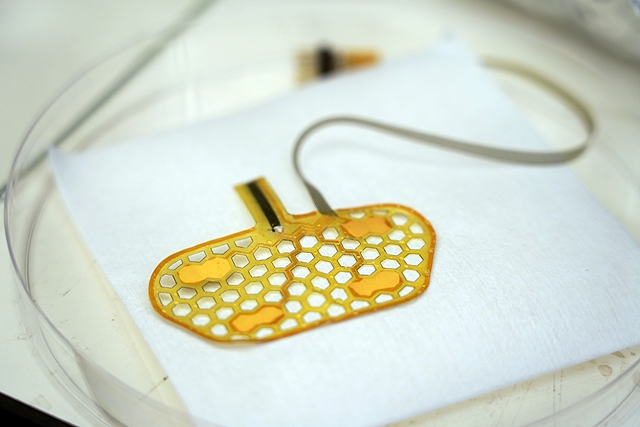18 Dec. 2019. A thin wearable device is shown to monitor muscles in the mouth and throat of people with difficulty swallowing, to help treat their condition. A speech disorder and engineering team from Purdue University in West Lafayette, Indiana describes the device in the 13 December issue of the journal Science Advances.
The researchers are seeking better tools to help people deal with dysphagia, a condition where the common act of swallowing is disrupted or blocked completely. While occasional difficulty in swallowing is not considered a cause for concern, chronic dysphagia regularly prevents food from traveling from the mouth to the stomach, sometimes causing pain, and interrupting food and water intake, as well as respiration. Dysphagia can also result from neurological disorders, such as stroke, cerebral palsy, or Parkinson’s disease. A paper published in 2014 says 9.4 million, or 1 in 25 adults in the U.S., experience dysphagia.
A team from the labs of speech science professor Georgia Malandraki and biomedical engineering professor Chi Hwan Lee designed their device to monitor a person’s swallowing activity in real time, which can provide people with swallowing problems with instantaneous feedback on mouth, tongue, and throat muscle movements. This feedback can help prescribe more personalized retraining of swallowing activity for people with dysphagia, as well as connect to remote systems for monitoring patients with the disorder.
“We want to provide a reliable, patient-friendly and affordable way to treat the millions of people with swallowing disorders,” says Malandraki in a university statement. “Many devices to help these people are expensive, not able to be taken home and not accessible in many rural areas.”
Malandraki, Lee, and colleagues fabricated the wearable and disposable device with copper electrode sensors printed in a honeycomb pattern on a thin, flexible polymide film. Polymides are strong chemical- and heat-resistant polymers, and the sensors measure muscle responses from the skin surface. The device is worn under the chin, but above the throat, and is connected to a battery-powered receiver unit clipped on the individual’s clothing, which relays captured data via Bluetooth signals.
“Our device is unique,” says Lee, “in that we specifically created it to work well with the small and intricate muscles associated with swallowing events. The sensor sticker is stretchable and flexible to work well with the skin and curvilinear head and neck shape, while the connected unit has electronic chips and more rigid components.”
The researchers first tested the swallow-monitoring device with a healthy 23 year-old volunteer. The results confirm the device can record and send on signals showing muscle contractions in the mouth and throat.
The team also tested the device with a person experiencing dysphagia as a result of Parkinson’s disease. The 70 year-old woman previously had undergone eight weeks of dysphagia therapy. The tests with liquid and soft pudding conducted with a trained speech-disorder specialist show the device captures malfunctioning muscle activity and more effort expended by the patient to swallow. The results also indicate the device provides data on neurological and muscular swallowing activity that can help in rehabilitation.
The researchers say clinical trials of the sensor device are underway. Lee and Malandraki patented the technology and started Curasis LLC, a company to commercialize the dysphagia device, in December 2018.
More from Science & Enterprise:
- Semiconductors Developed to Emulate Nerve Cells
- Wearable Sensor Analyzes Sweat, Measures Chemicals
- Infographic – Big Wearables Spending Growth Expected
- Liquid Injectable Electrodes Designed for Nerve Stimulation
- Graphene Material Designed for Wearable Devices
* * *


 RSS - Posts
RSS - Posts
[…] Device Offers Real-Time Monitoring of Swallowing Problems […]